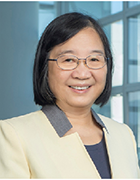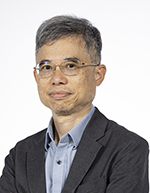- Shenzhen, China
- September 10-13, 2024
Speakers
Plenary Speakers for OGC 2024

René-Jean Essiambre
Bell Labs Fellow
Past-President of the IEEE Photonics Society (2022-2023)
René-Jean Essiambre received his Ph.D. in Physics from Laval University, Québec City, Canada, and pursued post-doctoral studies at the Institute of Optics, University of Rochester, NY. In 1997, he joined Bell Laboratories, then part of Lucent Technologies (now Nokia). Dr. Essiambre's research has spanned fiber lasers, optical fiber nonlinearity, advanced modulation formats, coherent detection, information theory applied to optical fibers, and space-division multiplexing. His current focus is on high-sensitivity quantum detection. With an extensive knowledge of fiber-optic communication systems, Dr. Essiambre has contributed to the design of numerous installed commercial systems. He has delivered over 100 invited talks, including the 2018 Physics Nobel Prize Lecture of Arthur Ashkin. His service includes chairing several conference committees for OFC, ECOC, CLEO, and IPC. He was program and general co-chair of CLEO Science & Innovation in 2012 and 2014, respectively. Dr. Essiambre's accolades include the 2005 Engineering Excellence Award from OSA and the distinction of Distinguished Member of Technical Staff (DMTS) at Bell Labs. He is a Fellow of the IEEE, OSA, Bell Labs, and the Institute of Advanced Studies of Technical University of Munich (IAS-TUM) in Germany. He also serves as an Ambassador of TUM. Dr. Essiambre recently completed his term as President of the IEEE Photonics Society for 2022 and 2023.
Speech Title: Technologies Approaching Capacity and Sensitivity Limits of Optical Communication Systems
Abstract: The advent of optical communication has enabled an unprecedented level of global connectivity. Over the past few decades, a series of optical and digital technologies have been developed and integrated into commercial communication systems to achieve this feat. Current fiber-optic communication systems operate near the practical limits of nonlinear fiber transmission, digital coherent detection, and error-correction coding. However, future optical communication systems demand even greater capacity, necessitating further innovations. This presentation will start with a brief historical overview of wired communication, focusing on how it relates to modern optical communication. We will clarify how signal power is limited in optical fibers and the application of Shannon information theory to establish limits on the rate of transmission of information over single-mode fibers. The presentation will then focus on new fiber designs for space-division multiplexing, which aim to overcome single-mode fiber capacity limits while remaining in a single fiber strand. The potential benefits of emerging optical fibers, such as the hollow-core fiber, will also be discussed. Finally, we will highlight a few optical quantum technologies based on single-photon quantum detectors and demonstrate how it can improve detection sensitivity.

Kei May Lau
IEEE Fellow, OSA Fellow, Hong Kong Academy of Engineering Sciences Fellow, CSR Fellow
Hong Kong University of Science & Technology, China
Kei May Lau is a Research Professor at the Hong Kong University of Science & Technology (HKUST). She received her degrees from the University of Minnesota and Rice University and served as a faculty member at the University of Massachusetts/Amherst before joining HKUST in 2000. Lau is an elected member of the US National Academy of Engineering, a Fellow of IEEE, Optica (formerly OSA), and the Hong Kong Academy of Engineering Sciences. She was also a recipient of the IPRM award, IET J J Thomson medal for Electronics, Optica Nick Holonyak Jr. Award, IEEE Photonics Society Aron Kressel Award, and Hong Kong Croucher Senior Research Fellowship. She was an Editor of the IEEE Transactions on Electron Devices and Electron Device Letters, an Associate Editor for the Journal of Crystal Growth and Applied Physics Letters.
Lau’s research focuses on the development of monolithic integration of semiconductor devices and systems on industry-standard silicon substrates. She was an early explorer of this approach. Her group was the first to demonstrate the highest mobility and millimeter-wave III-V transistors lattice-matched to InP grown directly on Si. She also led the development of the first 1.5 µm room-temperature electrically pumped III-V quantum dot lasers epitaxially grown on CMOS-standard (001) Si substrate by MOCVD. Recently, her group developed the lateral aspect ratio trapping (LART) technique to grow III-V active devices in the same plane as the Si layer enabling efficient coupling with Si-based passive components on silicon-on-insulator (SOI).
Speech Title: A New Paradigm for Photonic Integration – Direct Lateral III-V Growth on SOI for Lasers and More
Abstract: In addition to the speed and bandwidth advantages, sending data via photons instead of electrons can be much more energy efficient. Silicon photonics is being developed to extend integrated photonics adopting the highly successful Si IC infrastructure for tele/data- communications, and sensing.
In our laboratory, we have taken various approaches and developed high-quality III-V on silicon for lasers and photodetectors by direct hetero-epitaxy, including blanket and selective growth. The crystalline quality of these epitaxy has been verified by various material characterizations and successfully adopted for laser and other active device applications. For monolithic integration of Si photonics, efficient coupling of light between active and passive components is essential. We developed a novel lateral aspect ratio trapping (LART) technique to grow lasers and high-speed photodetectors on patterned commercial SOI substrates for integrated Si photonics. Multimode and single-mode lasing from lateral quantum wells (QWs) as the gain media using LART have been achieved in the 1433 -1630 nm band with varying dimensions of lasers. High-performance PDs coupled to Si tapers were also constructed on the monolithic InP/SOI platform with laterally grown PIN structures. This talk will describe these technologies in our toolbox.

Che Ting Chan
Hong Kong University of Science & Technology, China
C.T. Chan received his BSc degree from the University of Hong Kong in 1980 and his PhD degree from the University of California at Berkeley in 1985. He is currently serving as the Associate Vice-President for Research & Development at HKUST. He is also concurrently the Daniel C K Yu Professor of Science, Chair Professor of Physics, and the Director of Research Office of HKUST. He has been elected a Fellow of the American Physical Society and the Physical Society of Hong Kong and a member of the Hong Kong Academy of Sciences. His primary research interest is the theory and simulation of material properties.
Speech Title: Photonic Crystals as a Platform for Exploring New Frontiers in Physics
Abstract: Photonic crystals, materials with a periodic modulation of refractive index, offer unprecedented control over the flow of light, enabling a wide range of applications. For example, in optical communications, they function as filters, switches, and waveguides for integrated photonics. The ability to create high-quality optical cavities leads to low-threshold lasers and sensitive sensors. Their thermal management capabilities support energy-efficient buildings and radiative cooling. Integrating photonic crystals into solar cells can improve light trapping and energy conversion.
In this talk, I will focus on using photonic crystals as a versatile platform for exploring new frontiers in physics. Photonic crystals can be engineered to realize topological phenomena, leading to the emergence of robust edge states and topologically protected light propagation. This opens new avenues for designing topologically protected waveguides and optoelectronic devices. Furthermore, the introduction of non-Hermitian elements, such as optical gain or loss, in photonic crystals enables the exploration of non-Hermitian physics, leading to exceptional points and asymmetric light propagation. These unique physical phenomena not only advance our fundamental understanding of light-matter interactions but may also provide new design principles for next-generation photonic technologies.
